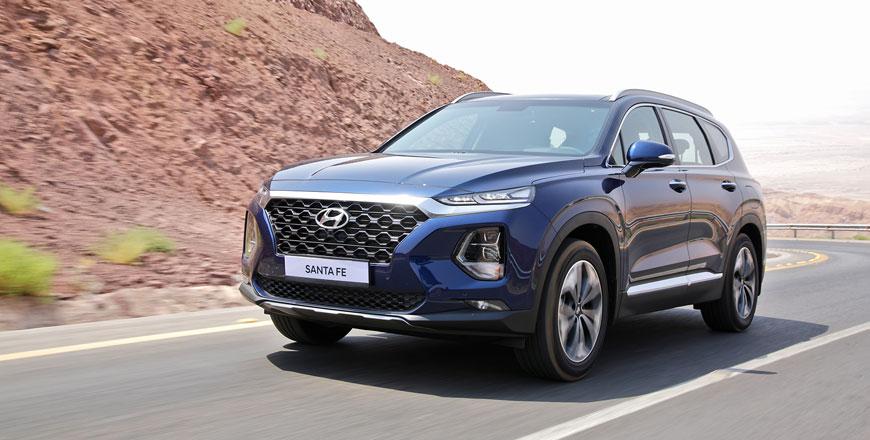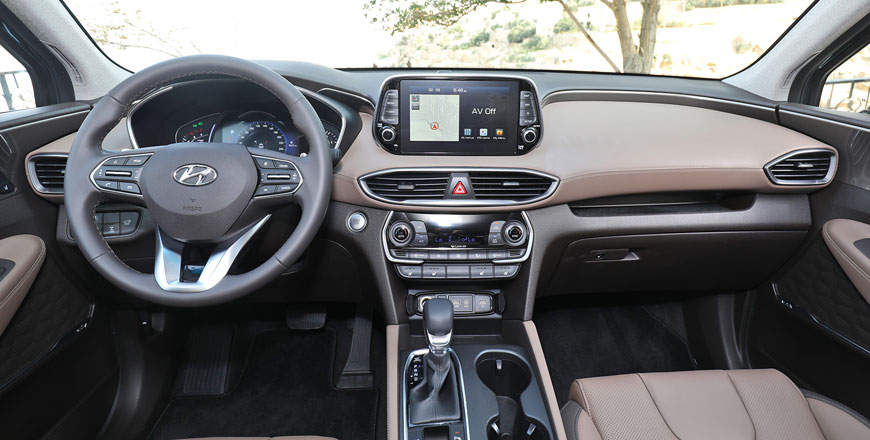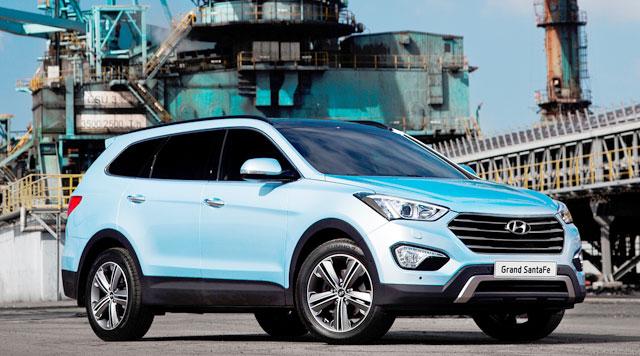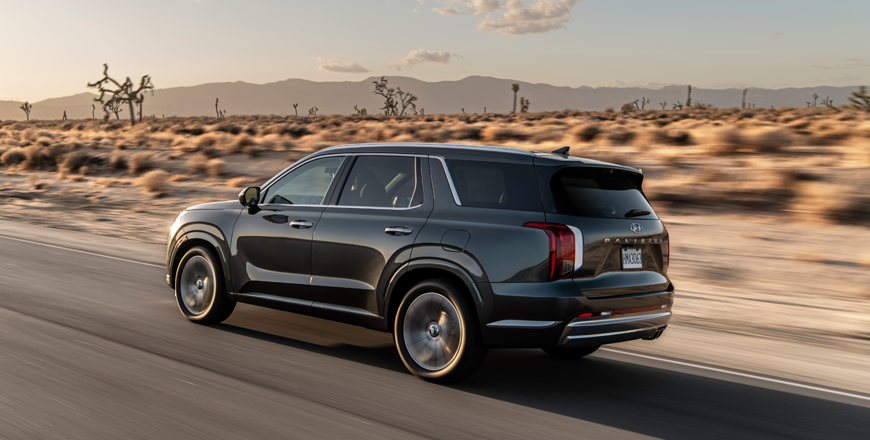You are here
Hyundai Santa Fe 3.5 V6 MPI: Family-focused SUV
By Ghaith Madadha - Sep 24,2018 - Last updated at Sep 24,2018

Photos courtesy of Hyundai

Launched regionally at a media event in Jordan earlier this month, Hyundai’s largest Santa Fe SUV offering adopts a more distinctive facia and makes expected incremental improvements in performance, equipment, refinement and trim levels.
A comfortable and convenient mid-size SUV, the Santa Fe is without radical change, however, Hyundai has redoubled efforts in making it a more passenger- and family-oriented product, with numerous features, solutions and attention to detail. The Santa Fe has also become better for drivers with improved steering, handling and ride characteristics.
With a long bonnet, longer wheelbase, shorter overhangs and more level waistline and roofline, the new Santa Fe has a clearly stronger presence on road and seems like a more confident and substantial looking machine. Inside, this translates into improved passenger head and legroom, and crucially so in the middle and third rows. Said to be emphasising maturity and confidence over outright aggression, the new Santa Fe nevertheless bears quite the intimidating face, with a vast, broad hexagonal “cascading grille” with widely spaced honeycomb mesh.
Confident presence
Underling a perception of width is a metallic strip running horizontally atop the grille and underneath the Santa Fe’s now moody and assertively squinting ultra slim, heavily browed and high set running lights. Meanwhile, the main lights aside a ridged and angularly muscular bumper section. Yet, more overt in along the flanks the Santa Fe features distinctively prominent and bulging body surfacing above its wheel-arches. Emphasising length and forward motion, this design touch pays homage to Marcello Gandini’s signature rear wheel-arch line, as famously featured on cars no less aggressive than the Lamborghini Countach and Maserati Shamal.
Benefitting from the use of 15 per cent more high strength steel than its predecessor, the new Santa Fe achieves a higher level of body rigidity for improved collision safety, handling ability and ride quality. Meanwhile underneath its bugling bonnet, the range-topping version of the Santa Fe receives a 3.5-litre multi-point fuel injection version of Hyundai’s tried and tested Lambda II V6 engine, while other petrol models depending on market, include multi-point and direct injection 2.4-litre and turbocharged 2-litre 4-cylinder engines. The Santa Fe’s engine is mated to a smooth and reasonable quick-shifting in-house developed 8-speed automatic gearbox.
Smooth and progressive
Progressive, eager and confident, the Santa Fe’s naturally aspirated V6 is responsive from low-end, and carries through to redline on an uninterrupted and rising stream of power, with 276bhp arriving at 6,300rpm and 247lb/ft torque peaking at 5,000rpm. Capable of 0-100km/h in 7.8-seconds and a 210km/h top speed, the Santa Fe returns 10.6l/100km quoted combined cycle fuel consumption. Refined and smooth, its generous mid-range torque output is progressively unleashed. However, on a particularly steep and winding route a more aggressive and closely spaced second gear ratio would have helped make more confident and seamless progress.
A road-biased crossover SUV, the Santa Fe benefits from 185mm ground clearance and a four-wheel-drive lock mode where power is distributed evenly between front and rear. With transverse engine layout it is a front-drive biased vehicle on road, with its most efficient Eco driving mode sending power exclusively frontwards and its default Comfort mode re-allocating 20 per cent of that rearwards. Sport mode allows for better agility and road-holding and a more balanced driving experience with less tendency for torque steer, by employing a 65:35 per cent front-to-rear power split that automatically alters to 50:50 per cent.
Comfort and control
Riding on MacPherson strut front and multi-link rear suspension and a more rigid frame, the new Santa Fe also benefits from a greater emphasis being placed on ride and handling qualities at Hyundai, and delivers noticeably improved dynamics than its predecessor. Tight into corners, its steering is sharper, quicker and more precise, while understeer has been significantly reduced. Grippy and balanced through corners, the new Santa Fe is a more agile vehicle than before, and one can even shift weight to the outside and rear to tighten a cornering line with a brief moment of oversteer before stability controls intervene.
Tauter and more focused, the New Santa Fe better controls roll through corners and rides with a more settled and buttoned down manner over, crests and dips and on rebound. Road imperfections are meanwhile processed with more comfort and control, while high speed stability is reassuring, stable and refined from noise, harshness and vibrations. Driving position is well adjustable, comfortable and supportive, while all-round visibility is improved owing to a lower waistline, more upright roof and bigger glasshouse. Its parking sensors and camera also help one to manoeuvre such a large SUV with relative ease into tight confines.
User-friendly utility
With cleaner and more user-friendly interior design, the new Santa Fe features improved materials, textures and layouts. Spacious inside for seven passengers and minimum of 547-litres of luggage that expands to a maximum 1,625-litres the new Santa Fe is designed with family use at the forefront of its intent. As such, and in addition to a host of standard and optional, new and improved safety, driver assistance and infotainment, the Santa Fe also features a safe exit assistance system for rear passengers, including a warning if they open the door at the wrong time.
Expected by Hyundai to receive a 5-star Euro NCAP rating when it is officially tested, the Santa Fe is somewhat idiot-proof and features a Rear Occupant Alert so careless parents do not “forget” their children alone in the car, while other small features have children in mind and include tight lines for the window blinds and an automatic middle row folding system with a low positioned button to make it safe and easy to use for children. Third row passengers also get special ingress and egress handles moulded into the C-pillar.
TECHNICAL SPECIFICATIONS
- Engine: 3.5-litre, aluminium block/head, inline V6-cylinders
- Bore x stroke: 92 x 87mm
- Compression ratio: 10.6:1
- Valve-train: DOHC, 24-valve, continuously variable valve timing
- Gearbox: 8-speed automatic, four-wheel-drive
- Power, BHP (PS) [kW]: 276 (280) [206] @6,300rpm
- Specific power: 79.5BHP/litre
- Torque, lb/ft (Nm): 247.8 (336) @ 5,000rpm
- Specific torque: 71.3Nm/litre
- 0-100km/h: 7.8-seconds
- Top speed: 210km/h
- Fuel consumption, urban/extra-urban/combined: 14.6-/8.3-/10.6-litres/100km
- CO2 emissions, combined: 253g/km
- Length: 4,770mm
- Width: 1,890mm
- Height: 1,680mm
- Wheelbase: 2,765mm
- Overhang, F/R: 940/1,065mm
- Ground clearance: 185mm
- Headroom, F/M/R: 1,016/995/917mm
- Leg room, F/M/R: 1,120/1,001/746mm
- Shoulder room, F/M/R: 1,500/1,450/1,344mm
- Luggage volume, min/max: 547-/1,625-litres
- Kerb weight: 1900kg (est.)
- Steering: Electric-assisted rack and pinion
- Suspension, F/R: MacPherson struts/multi-link
- Tyres: 235/55R19
Related Articles
Winner of the inaugural 2014 Middle East Car of the Year annual awards’ Best Midsize SUV segment, the Hyundai Grand Santa Fe is among the Korean automotive giant’s best efforts and best resolved vehicles in its’ given segment.
Launched in late 2019 as Hyundai’s big flagship SUV, the Palisade struck an assertive aesthetic tone combined with a capable engine, confide
Developed primarily for its biggest market, the latest iteration of Nissan’s behemoth Patrol SUV launched globally in Abu Dhabi last week.


















